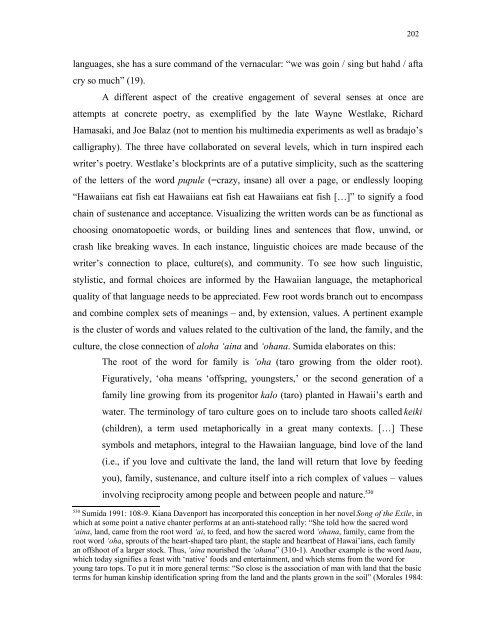A Paradise Lost - KOPS - Universität Konstanz
A Paradise Lost - KOPS - Universität Konstanz
A Paradise Lost - KOPS - Universität Konstanz
Create successful ePaper yourself
Turn your PDF publications into a flip-book with our unique Google optimized e-Paper software.
languages, she has a sure command of the vernacular: “we was goin / sing but hahd / afta<br />
cry so much” (19).<br />
A different aspect of the creative engagement of several senses at once are<br />
attempts at concrete poetry, as exemplified by the late Wayne Westlake, Richard<br />
Hamasaki, and Joe Balaz (not to mention his multimedia experiments as well as bradajo’s<br />
calligraphy). The three have collaborated on several levels, which in turn inspired each<br />
writer’s poetry. Westlake’s blockprints are of a putative simplicity, such as the scattering<br />
of the letters of the word pupule (=crazy, insane) all over a page, or endlessly looping<br />
“Hawaiians eat fish eat Hawaiians eat fish eat Hawaiians eat fish […]” to signify a food<br />
chain of sustenance and acceptance. Visualizing the written words can be as functional as<br />
choosing onomatopoetic words, or building lines and sentences that flow, unwind, or<br />
crash like breaking waves. In each instance, linguistic choices are made because of the<br />
writer’s connection to place, culture(s), and community. To see how such linguistic,<br />
stylistic, and formal choices are informed by the Hawaiian language, the metaphorical<br />
quality of that language needs to be appreciated. Few root words branch out to encompass<br />
and combine complex sets of meanings – and, by extension, values. A pertinent example<br />
is the cluster of words and values related to the cultivation of the land, the family, and the<br />
culture, the close connection of aloha ‘aina and ‘ohana. Sumida elaborates on this:<br />
The root of the word for family is ‘oha (taro growing from the older root).<br />
Figuratively, ‘oha means ‘offspring, youngsters,’ or the second generation of a<br />
family line growing from its progenitor kalo (taro) planted in Hawaii’s earth and<br />
water. The terminology of taro culture goes on to include taro shoots called keiki<br />
(children), a term used metaphorically in a great many contexts. […] These<br />
symbols and metaphors, integral to the Hawaiian language, bind love of the land<br />
(i.e., if you love and cultivate the land, the land will return that love by feeding<br />
you), family, sustenance, and culture itself into a rich complex of values – values<br />
involving reciprocity among people and between people and nature. 530<br />
530 Sumida 1991: 108-9. Kiana Davenport has incorporated this conception in her novel Song of the Exile, in<br />
which at some point a native chanter performs at an anti-statehood rally: “She told how the sacred word<br />
‘aina, land, came from the root word ‘ai, to feed, and how the sacred word ‘ohana, family, came from the<br />
root word ‘oha, sprouts of the heart-shaped taro plant, the staple and heartbeat of Hawai’ians, each family<br />
an offshoot of a larger stock. Thus, ‘aina nourished the ‘ohana” (310-1). Another example is the word luau,<br />
which today signifies a feast with ‘native’ foods and entertainment, and which stems from the word for<br />
young taro tops. To put it in more general terms: “So close is the association of man with land that the basic<br />
terms for human kinship identification spring from the land and the plants grown in the soil” (Morales 1984:<br />
202

















